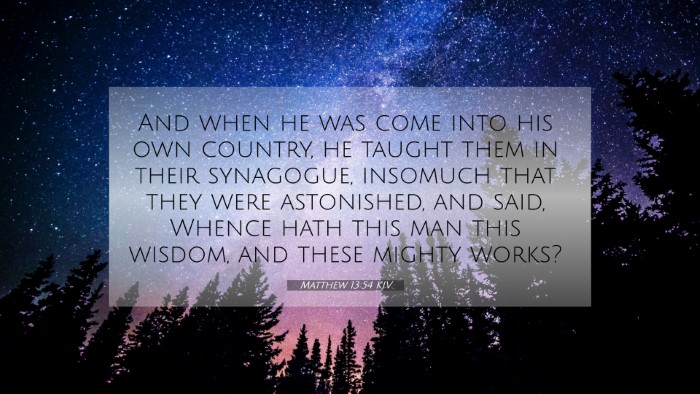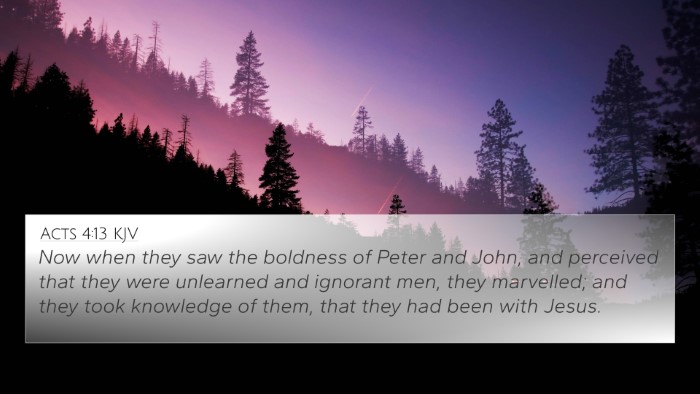Understanding Matthew 13:54
Verse: Matthew 13:54 - "And coming to His hometown, He taught them in their synagogue, so that they were astonished, and said, 'Where did this man get this wisdom and these mighty works?'"
Contextual Overview:
This verse occurs in the context of Jesus returning to His hometown of Nazareth. It highlights the reaction of the local people to Jesus' miraculous teachings and deeds. The astonishment of the crowd reflects both a sense of wonder and skepticism regarding His authority and origin.
Interpretation Insights
-
Matthew Henry's Commentary:
Henry notes that this incident illustrates the sentiments of familiarity and contempt that often hinder appreciation for those who are close to us. The local people were amazed at His wisdom and works, yet they struggled to reconcile these with their knowledge of His humble beginnings.
-
Albert Barnes' Exposition:
Barnes emphasizes that the people’s astonishment stemmed from the contrast between Jesus’ current status as a teacher and miracle worker, and their previous knowledge of Him as the carpenter's son. This illustrates a common human tendency to doubt the extraordinary in those we consider ordinary.
-
Adam Clarke's Commentary:
Clarke points out that the term "astonished" here indicates a mixture of admiration and incredulity. The people were struck by the wisdom of Jesus, yet the question of His origins clouded their minds, leading to a lack of faith in His true identity as the Messiah.
Key Themes in Matthew 13:54
- Familiarity Breeds Contempt: The local people’s disbelief underscores the idea that those closest to us may struggle the most to accept our capabilities and achievements.
- The Wisdom of Jesus: His teachings reflect a divine source of wisdom that transcends earthly education, emphasizing His unique role in God’s plan.
- Miracles and Belief: The miracles performed by Jesus are designed to bolster faith; however, local skepticism indicates that miracles alone are not sufficient for belief.
Bible Verse Cross-References
Matthew 13:54 connects to several other scriptures that enhance its meaning:
- John 1:46: "Can anything good come out of Nazareth?" - This verse reflects the doubt regarding Jesus' origin.
- Luke 4:24: "Truly, I say to you, no prophet is acceptable in his hometown." - This statement reinforces the sentiment found in Matthew 13:54 regarding rejection based on familiarity.
- Mark 6:2-3: This parallel account emphasizes the astonishment of the people and their doubts about Jesus as a "carpenter, the son of Mary."
- Matthew 11:21-23: Reflects on the cities where Jesus performed miracles and their resulting accountability before God.
- Matthew 9:24: Jesus often faced skepticism even in the presence of His miracles, showcasing human disbelief in the face of divine power.
- Matthew 12:13: The contemplation of Jesus' actions sometimes prompted different perceptions of authority and surpassing wisdom.
- John 7:15: "The Jews therefore marveled, saying, 'How is it that this man has learning, when he has never studied?'" - Mirrors the astonishment mentioned in Matthew 13:54.
Thematic Bible Verse Connections
Matthew 13:54 can be examined through various thematic connections with other verses. Below are some thematic links:
- Identity and Authority: In John 10:25, Jesus affirms that His miracles testify to His divine authority, warranting belief.
- Rejection and Acceptance: Reflecting on Romans 10:14, we see the struggle of belief concerning those who lack knowledge of Christ's true identity.
- Prophetic Patterns: Jesus’ rejection follows the pattern laid out for prophets in Jeremiah 1:19, where the prophet faces opposition, paralleling the theme in Matthew 13:54.
Conclusion
In summary, Matthew 13:54 invites believers to reflect on the complex dynamics of familiarity, skepticism, and faith. The combined insights from public domain commentaries reveal that, while Jesus was recognized for His wisdom and miracles, deep-seated biases often inhibited full acceptance of His identity and mission as the Messiah. Understanding this verse through the lens of cross-referencing related biblical texts enriches our appreciation for the intricate dialogue within the scriptures.














